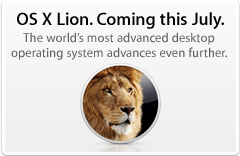A previous article said Lion would be released July 14th. That date has come and gone, but where is Lion? Steve Jobs in his presentation at WWDC said Lion would ship “some time in July.” When in July? Guesses from July 6th to July 14th to July 26th have all been thrown in the air. Even the best Apple pundits have been stumped.
I think an unintended consequence of releasing software as download only has presented itself: there is no physical stock of install discs to tip the Apple community as to when a release will definitely happen.
What does it matter? Well, for one, Mac Geeks such as myself are forced to check the rumor mills constantly for some sign of Lion approaching. It also shows just how much control Apple has over its products. I must admit that they have been playing their hand very close to the chest to have fooled so many websites. Another implication is that those wishing to prep his or her Macs for the upgrade have no idea when they’ll need to get it done by.
However, sources are now guessing more confidently that July 26th will be it.
What do you think? Will uncertainty cloud the release of future download only upgrades, or does it not matter to know when an OS upgrade will release?


 What is Apple’s Back to School Promotion? Basically, the deal is that when you purchase a new qualifying Mac with Apple education pricing from June 16, 2011, through September 20, 2011, you’ll get a free $100 Back to School Card. You can use the Back to School Card on the Mac App Store, the App Store, the iTunes Store, and the iBookstore.
What is Apple’s Back to School Promotion? Basically, the deal is that when you purchase a new qualifying Mac with Apple education pricing from June 16, 2011, through September 20, 2011, you’ll get a free $100 Back to School Card. You can use the Back to School Card on the Mac App Store, the App Store, the iTunes Store, and the iBookstore. If you want to upgrade your Mac to OS X Lion, you don’t have to worry about going to the store and having to install a bunch of discs from a box; you can just go to the Mac App Store and buy Lion for $29.99. You also need to prepare your Mac for Lion. Your Mac must have an Intel Core 2 Duo, Core i3, Core i5, Core i7, or Xeon processor for your Mac to be able to run Lion. You can check to see what processor your Mac has by clicking the Apple icon on the top left of your display and choosing About This Mac. Your Mac must also be up to date with the latest version of OS X Snow Leopard. Click the Apple icon and choose Software Update to install version 10.6.8 if you haven’t done so already. After you have done those steps, you can open the Mac App Store and purchase OS X Lion.
If you want to upgrade your Mac to OS X Lion, you don’t have to worry about going to the store and having to install a bunch of discs from a box; you can just go to the Mac App Store and buy Lion for $29.99. You also need to prepare your Mac for Lion. Your Mac must have an Intel Core 2 Duo, Core i3, Core i5, Core i7, or Xeon processor for your Mac to be able to run Lion. You can check to see what processor your Mac has by clicking the Apple icon on the top left of your display and choosing About This Mac. Your Mac must also be up to date with the latest version of OS X Snow Leopard. Click the Apple icon and choose Software Update to install version 10.6.8 if you haven’t done so already. After you have done those steps, you can open the Mac App Store and purchase OS X Lion.

